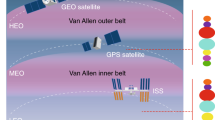Abstract
The composition and intensity of ionizing radiation heavily depends on the environment. Ionizing radiation is severe in space, but also terrestrial electronics must consider potential hazards e.g. radiation caused by energetic solar particle events. High energy protons, electrons and ions can lead to malfunction or damage of integrated circuits (IC). In this paper the dominant radiation effects to ICs are presented together with an overview of hardening techniques.
Zusammenfassung
Zusammensetzung und Intensität der ionisierenden Strahlung sind stark von der Anwendungsumgebung abhängig. Im Weltraum ist sie besonders intensiv, jedoch muss auch für elektronische Schaltungen in terrestrischen Applikationen die mögliche Gefahr der z. B. von Solaraktivität entstandenen ionisierenden Strahlung berücksichtigt werden. Hochenergetische Protonen, Elektronen oder Ionen können zu Störungen oder Beschädigungen führen. In dieser Arbeit werden die grundlegenden Effekte ionisierender Strahlung betrachtet sowie ein Überblick über aktuelle Techniken zur Reduktion ihrer Auswirkungen gegeben.









Similar content being viewed by others
References
Amusan, O. A., et al. (2009): Mitigation techniques for single-event-induced charge sharing in a 90-nm bulk CMOS process. IEEE Trans. Device Mater. Reliab., 9(2), 311–317.
Aubuchon, K. G. (1971): Radiation hardening of P-MOS devices by optimization of the thermal SiO2 gate insulator. IEEE Trans. Nucl. Sci., NS-18, 117.
Autran, J. L., Balland, B., Barbottin, G. (1999): Charge pumping techniques—their use for diagnosis and interface state studies in MOS transistors. In G. Barbottin, A. Vapaille (Eds.), Instabilities in silicon devices, new insulators, devices and radiation effects (pp. 405–494). Amsterdam: Elsevier.
Barnaby, H. (2006): Total-ionizing-dose effects in modern CMOS technologies. IEEE Trans. Nucl. Sci., 53(6), 3103–3121.
Calin, T., Nicolaidis, M., Velazco, R. (1996): Upset hardened memory design for submicron CMOS technology. IEEE Trans. Nucl. Sci., 43(6), 2874–2878.
Fahrner, W. R. (1999): An overview of radiation-matter interactions. In G. Barbottin, A. Vapaille (Eds.), Instabilities in silicon devices, new insulators, devices and radiation effects (pp. 577–579). Amsterdam: Elsevier.
Fleetwood, D. (1996): Fast and slow border traps in MOS devices. IEEE Trans. Nucl. Sci., 43(3), 779–786.
Fleetwood, D., et al. (1995a): Border traps: issues for MOS radiation response and long-term reliability. Microelectron. Reliab., 35(3), 403–428.
Fleetwood, D., et al. (1995b): Effects of interface traps and border traps on MOS postirradiation annealing response. IEEE Trans. Nucl. Sci., 42(6), 1698–1707.
Gaillard, R. (2011): Soft errors in modern electronic systems. Frontiers in electronic testing.
Gregory, B. L. (1975): Process controls for radiation-hardened aluminum gate bulk silicon CMOS. IEEE Trans. Nucl. Sci., NS-22, 2295.
Holmes-Siedle, A., Adams, L. (2007): Handbook of radiation effects. London: Oxford University Press.
Hughes, H. L., Benedetto, J. M. (2003): Radiation effects and hardening of MOS technology: devices and circuits. IEEE Trans. Nucl. Sci., 50(3), 500–521.
Knoll, G. F. (2010): Radiation detection and measurement. 4th ed. New York: Wiley.
Kwon, J., Motta, A. T. (2000): Gamma displacement cross-sections in various materials. Ann. Nucl. Energy, 27, 1627–1642.
Nowlin, N., Bailey, J., Turfler, B., Alexander, D. (2004): A total-dose hardening-by-design approach for high speed mixed-signal CMOS integrated circuits. Int. J. High Speed Electron. Syst., 14, 367–378.
Oldham, T. R., McLean, F. B. (2003): Total ionizing dose effects in MOS oxides and devices. IEEE Trans. Nucl. Sci., 50(3), 483–498.
Pan, D., Li, H., Wilamowski, B. (2003): A radiation-hard phase-locked loop. In ISIE’03, pp. 901–906.
Peel, J. L., Kinoshita, G. (1972): Radiation-hardened complementary MOS using SiO2 gate insulators. IEEE Trans. Nucl. Sci., NS-19, 271.
Schroder, D. (2006): Semiconductor material and device characterization. New York: Wiley.
Shaneyfelt, M. R., Dodd, P. E., Draper, B. L., Flores, R. S. (1998): Challenges in hardening technologies using shallow-trench isolation. IEEE Trans. Nucl. Sci., 45, 2584.
Author information
Authors and Affiliations
Corresponding author
Rights and permissions
About this article
Cite this article
Bezhenova, V., Michalowska-Forsyth, A.M. Effects of ionizing radiation on integrated circuits. Elektrotech. Inftech. 133, 39–42 (2016). https://doi.org/10.1007/s00502-015-0380-8
Received:
Accepted:
Published:
Issue Date:
DOI: https://doi.org/10.1007/s00502-015-0380-8




